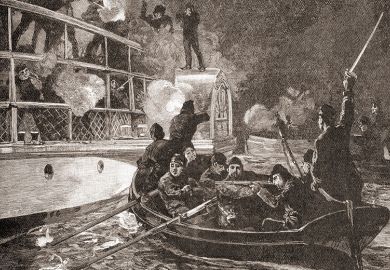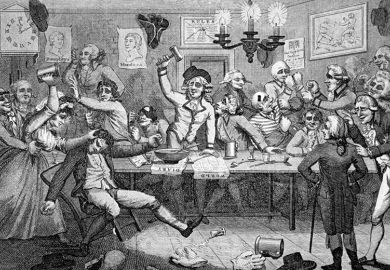Slave ships are everywhere. In downtown Chicago in 2012, I walked past a street protest in which a black Muslim man carried a placard decrying the evils of American capitalism. It was the early years of the Occupy Movement and Arab Spring, so such critique was not surprising. But, as I passed by, the back of his placard became visible.
On it was the iconic depiction of the Brookes, the 18th-century Liverpool slave ship documented for its abuses in overcrowding. This simple, powerful image of the violence and dehumanisation involved in transporting enslaved Africans to the Americas has seized attention ever since the Plymouth Abolition Society created it in 1788.
Originally intended to galvanise opposition to British slaving, the image took on a life of its own. In iterative practices that Cheryl Finley calls a “mnemonic aesthetics”, black British and American artists have appropriated it to resist modern racial inequities and create new, often revolutionary understandings of black diasporic identity.
Part I describes the icon’s origin, circulation and evolution. Finley provides an exacting account of each variant as it was designed and reproduced. This analysis does not produce a radically new account of the icon’s significance at the time of its creation, in part because she chooses not to engage with any scholarship on abolition that is more recent than 2007.
Newer work on the Middle Passages, abolitionist networks, broader Atlantic visual cultures of the slave trades, as well as theoretical work on the ocean as a site of death and cross-cultural exchange would have enriched her argument. That deficit, along with the level of detail, overwhelms the interpretive payoff.
More discussion of the architectural and scientific gaze would have contextualised the icon’s power to seem, in the words of white abolitionist Thomas Clarkson, a “real representation”. All representations, by virtue of being representations, are fictitious – what Clarkson signals is the success with which these novel methods succeeded in placing the thing itself before viewers, rooting the call to protest in the self-evident wrongness of the slave ship.
The most compelling analysis arrives in Parts II and III, which examine 20th- and 21st-century black American and British invocations of the icon. Finley explores works from the New Negro (Harlem Renaissance) and Black Arts movements, independence and black power struggles, and the postcolonial era.
This collage offers a remarkable display of diasporic creativity, sounding an effective counterpoint to Part I’s meticulous accounting of the trauma of transportation. The book wonderfully shows how the ship travelled from its 18th-century departure port of protest to multiple destinations – prison reform movements, anti-capitalist campaigns, resistance to racial and sexual discrimination, and refugee advocacy. More, perhaps, might be made of how male and female artists differ in their reclamations and iterations.
The slave trade icon, in Finley’s analysis, evokes exclusion – from human rights, protection under law, equality – by distilling bodily feelings of suffocation, wrongful treatment, oppression and struggle. Yet in diasporic collage it has also generated a breathtaking vision of creative human practices that liberate and demand liberation, through a repeated return to the past and its present reverberations. It calls out, as artist David Thorne puts it: “What have you done [for freedom] today?”
Catherine Molineux is associate professor of history at Vanderbilt University. She is completing a book on self-emancipation, storytelling and abolition in the 18th-century British Atlantic.
Committed to Memory: The Art of the Slave Ship Icon
By Cheryl Finley
Princeton University Press 320pp, £40.00
ISBN 9780691136844
Published 25 May 2018
POSTSCRIPT:
Print headline: The journey of the slave ship
Register to continue
Why register?
- Registration is free and only takes a moment
- Once registered, you can read 3 articles a month
- Sign up for our newsletter
Subscribe
Or subscribe for unlimited access to:
- Unlimited access to news, views, insights & reviews
- Digital editions
- Digital access to THE’s university and college rankings analysis
Already registered or a current subscriber?








